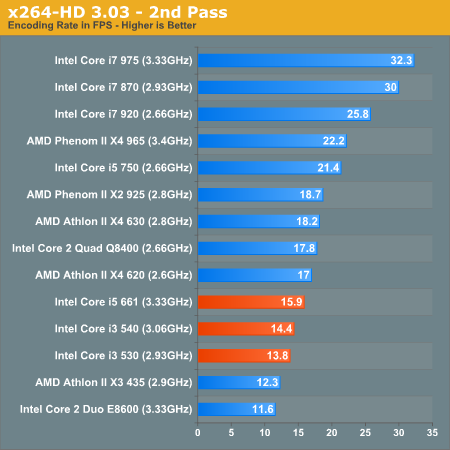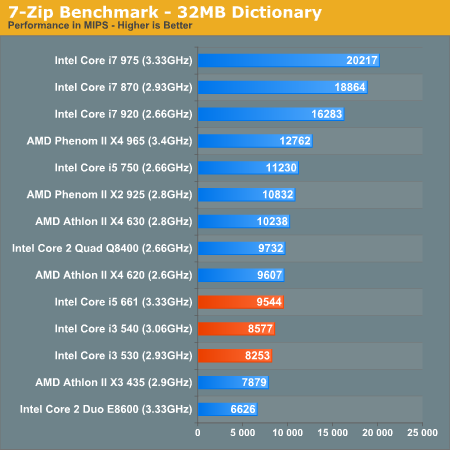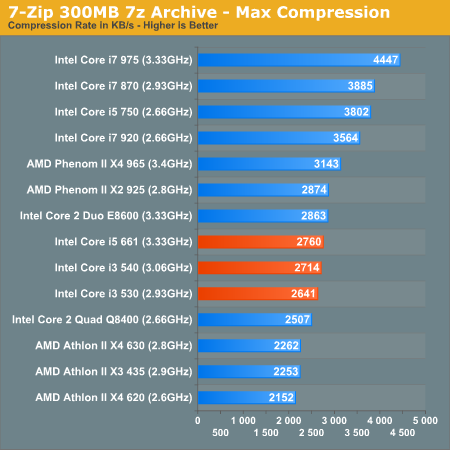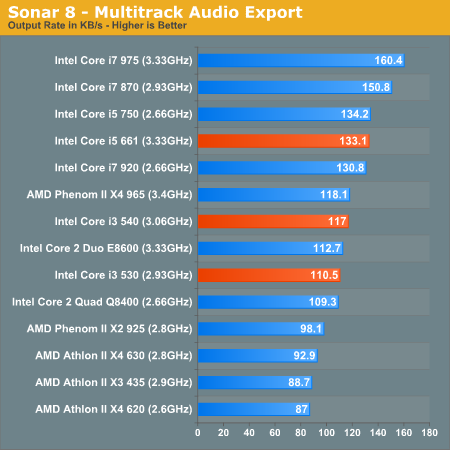The Clarkdale Review: Intel's Core i5 661, i3 540 & i3 530
by Anand Lal Shimpi on January 4, 2010 12:00 AM EST- Posted in
- CPUs
Windows 7 Application Performance
We're testing out a few new additions to our Bench database, so what we've got here are some updated application tests run under Windows 7. The CPUs compared are going to be different since we don't have as much historical data, but we'll be building it up over the coming months.
x264 HD Encoding Performance
It's what you've all been asking for - our x264 encoding test with an updated version of x264. In this case we're using TechARP's x264-HD 3.03 bench and x264 version 1342.

As expected. The dual-core chips just can't compete with the triple and quad-core competitors.

7-zip Benchmark & Performance
We use WinRAR for our compression test under Vista, but more and more users are switching to 7-zip. The performance is more CPU dependent so we're going to look at it. First up is the built in 7-zip benchmark:

With no I/O bottlenecks the benchmark scales very well with CPU speed and core count. As a result, our faithful Clarkdales don't look all that great. In the real world though, Clarkdale performance (at least from the i3s) is respectable.
Here we're taking the same 300MB set of images from our WinRAR test and are compressing them using 7-zip. We divide file size by completion time to get compression speed in KB/s:

Sonar 8 Multi-track Audio Export
We've had some requests for digital audio workstation benchmarks so we're adding a multi-track audio export from Sonar 8. Performance is expressed in KB/s:

This is one of those situations where the i5 661 performs well for its price, but the real stars are the i3 540/530 again. They perform like CPUs much more expensive than they are.










93 Comments
View All Comments
Paladin1211 - Monday, January 4, 2010 - link
On page 13, in WoW benchmark, the Core i5 750 outperforms the Core i7 870 by more than 30% (92.3 fps vs 70.6 fps). Anything wrong here?Crimson67 - Tuesday, January 5, 2010 - link
WoW doesn't seem to like hyperthreading, it's the only explanationereavis - Wednesday, January 6, 2010 - link
is it using the hyperthread core on the 870 but a true core on the 750? That would certainly slow it down. If it's using a true core on both it should be better still.Dyzios - Monday, January 4, 2010 - link
Remember NVIDIA Hybrid idea, to have two GPUs ? - one weak for 2D/light 3D graphics and powerful discrete GPU for gaming? Those CPU makes sense for this approach - however Radeon 5870 also has good point with optimized low idle power consumption. Maybe still there is point as even Radeon cannot go very low as GPU on-die. The only question is to have capability to switch HDMI output between on-die GPU and discrete.I wonder how this works currently - still needed to stick to DVI output from Radeon or can be combined?Zool - Tuesday, January 5, 2010 - link
If the 40nm 5600 series cards will show the same improvments in power usage than the 5800 series than u can forget the intels GMA graphic.I think that for a 2D card/3D discret card u can buy a mobo with a dirty cheap intel GMA on it clocked much lower if u realy need.
silverblue - Wednesday, January 6, 2010 - link
The graphics comparison isn't exactly fair but in the end, it's not something AMD should be too worried about. The i5-661, with its 900MHz 45nm GPU, is being compared to the old 790GX's HD 3300 which operates at 700MHz on a 55nm process. I admit, in the benchmarks we're talking the best i5 vs. the best AMD has to offer, but considering...a) the relative performance of the i5-750 as compared to the PII X4 965 which is usually manifested as an advantage
b) the fact that the 32nm i5s can increase their core speed by 133MHz and 266MHz thanks to Turbo depending on the number of active cores
c) most games still aren't designed to take full advantage of multithreading so four cores may not yield a tangible performance increase
...then AMD's still in the lead for IGPs. If the 3300 had been clocked at 900MHz, would it have lost even one of the listed benchmarks? I'm not sure it would have. What's more, we're still talking a 55nm part; we all know of TSMC's issues with the 40nm process and AMD going fablress, so is it unreasonable to expect that AMD could move their IGP production en masse to 40nm with TSMC or 45nm with GlobalFoundries?
In closing, it's a big step forward for Intel, however if AMD came out with a higher clocked 40/45nm IGP then, Sideport or not, new tech or not, AMD would be far ahead, at least on gaming terms. Sideport does very little for the performance of current AMD IGPs, anyway.
I just wish AMD were able to release a Clarkdale competitor sooner rather than later.
ruetheday - Friday, January 8, 2010 - link
the IGP on Clarkdale isn't maxed out at 900Mhz; It too can be overclocked significantly. Here's an article on techgage showing an OC to 1133, for example.Remember that Intel is very conservative on binning parts to ensure no issues with reliability over time (compare vs nvidia mobile gpus).
silverblue - Friday, January 8, 2010 - link
Maybe so, however a 40/45nm AMD part could reach similar clockspeeds. I just don't think that, clock for clock, the new Intel IGP on the Clarkdale die is as powerful as anything AMD or nVidia can produce on the same scale. It's a good step forwards, just not the leadership that some may have been expecting.silverblue - Wednesday, January 6, 2010 - link
Slight mistake... second best 32nm i5 that Intel has to offer. However, I doubt the performance increase over the 661 will be very noticable with the IGP; won't it be clocked the same in both?Zool - Monday, January 4, 2010 - link
The irony is the biggest drawback of these cpu-s is the 45nm intel graphic on other die with the memmory controler. The die savings from 45nm vs 32nm are quite big.If they would make just 32nm dual core nehalem with memory controler on die it would be still much smaller(and only litle bigger than the clarkdale without imc) than the GMA die with memmory controler.
The whole thing would be solved with everything as one on 32nm.
I think plenty of people just wait for 32nm quad core nehalems without the useless GMA graphic.
Actualy what is the cost of dirty cheap GMA in penryn based 3 package boards. Like 5-10 dolars ?